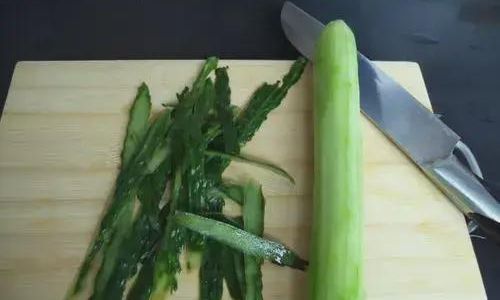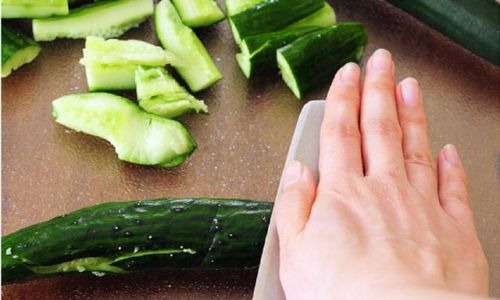Introduction
Cucumbers, with their crisp texture and refreshing taste, are a staple in salads, sandwiches, and beverages across the globe. Yet, a seemingly simple question divides home cooks, nutritionists, and food enthusiasts alike: Should you peel a cucumber before eating it? This debate transcends mere culinary preference, delving into nutrition, food safety, cultural traditions, and environmental sustainability. This article explores the multifaceted aspects of this dilemma, offering insights to help you decide whether to embrace the peel or bid it farewell.
The Nutritional Powerhouse: What Lies Beneath (and On) the Skin
Cucumbers belong to the Cucurbitaceae family, alongside melons and squashes, and are celebrated for their high water content (about 95%) and low-calorie profile. However, the peel—often dismissed as inedible or bitter—harbors a treasure trove of nutrients that advocates argue should not be wasted.
Fiber Fortification
The peel is a rich source of dietary fiber, which aids digestion, promotes gut health, and helps regulate blood sugar levels. A single medium cucumber with its skin provides approximately 2 grams of fiber, nearly 8% of the recommended daily intake for adults. Removing the peel slashes this fiber content by half, potentially diminishing its digestive benefits.
Vitamin and Mineral Boost
Cucumber peels are packed with vitamins K, C, and A, as well as potassium and magnesium. Vitamin K, crucial for blood clotting and bone health, is particularly concentrated in the skin. A study published in the Journal of Food Composition and Analysis found that unpeeled cucumbers contain up to 30% more vitamin K than their peeled counterparts. Similarly, the peel’s vitamin C content, an antioxidant that supports immune function and skin health, is significantly higher than in the flesh alone.
Antioxidants and Phytonutrients
The green hue of cucumber peels comes from chlorophyll, a pigment linked to detoxification and anti-inflammatory properties. Additionally, the peel contains flavonoids like quercetin and kaempferol, which have antioxidant and anti-cancer potential. A 2020 review in Nutrients highlighted that these compounds may reduce the risk of chronic diseases when consumed regularly.

Pesticide Concerns: To Wash or to Organic?
Despite their nutritional merits, cucumber peels can harbor pesticide residues, raising concerns about food safety. The Environmental Working Group (EWG) consistently lists cucumbers on its “Dirty Dozen” list, which identifies produce most likely to contain pesticide contaminants. Conventional cucumbers may be treated with fungicides and wax coatings to extend shelf life, which can trap pesticides on the skin.
Mitigating Risks
For those hesitant to consume unpeeled cucumbers, thorough washing is non-negotiable. The U.S. Food and Drug Administration (FDA) recommends scrubbing produce under running water to remove surface contaminants. Using a vegetable brush can enhance this process. Alternatively, peeling the cucumber eliminates most pesticide risks but also strips away nutrients.
Organic Alternatives
Organic cucumbers, grown without synthetic pesticides, offer a middle ground. While they may still contain natural waxes or residues, their peels are generally safer to consume. However, organic options are often pricier, making accessibility a barrier for some consumers.
Texture, Taste, and Culinary Versatility
The decision to peel a cucumber often hinges on sensory preferences and culinary applications. The peel’s texture—crisp yet slightly bitter—can enhance or detract from a dish, depending on context.
Texture Play
In dishes like Greek salads or tzatziki, the peel’s firmness adds a satisfying crunch. Chefs often retain the skin for visual appeal, as its vibrant green color contrasts beautifully with other ingredients. Conversely, in creamy soups or smoothies, the peel’s fibrous texture may be undesirable, prompting removal.

Taste Considerations
Cucumber peels contain cucurbitacins, compounds that contribute to bitterness. While modern cultivars are bred for mildness, some varieties (especially wild cucumbers) retain a pronounced bitter edge. Soaking sliced cucumbers in salted water for 10–15 minutes can mellow this bitterness, as can rubbing the cut end of the cucumber until a foam appears—a traditional method to reduce astringency.
Culinary Applications
- Salads and Slaws: Unpeeled cucumbers shine in raw preparations, where their texture and color elevate the dish.
- Pickling: The peel’s firmness helps pickled cucumbers retain their shape during fermentation.
- Smoothies and Juices: Peeled cucumbers yield a smoother consistency, though some blenders can handle unpeeled varieties.
Cultural Perspectives: From Peel-Free Traditions to Skin-On Revival
Cucumber preparation varies widely across cultures, reflecting historical, agricultural, and culinary traditions.
Eastern Influences
In many Asian cuisines, cucumbers are often peeled to remove perceived bitterness, especially in dishes like sunomono (Japanese vinegar salads) or Korean oi-muchim (spicy cucumber salad). However, younger generations are rediscovering the peel’s nutritional benefits, leading to a resurgence of unpeeled recipes.
Western Trends
European and American culinary practices historically favored peeled cucumbers, particularly in classic dishes like cucumber sandwiches. Yet, the farm-to-table movement has sparked interest in “nose-to-tail” vegetable consumption, encouraging chefs to utilize the entire cucumber, peel included.

Middle Eastern Traditions
In Levantine cuisine, cucumbers are rarely peeled for dishes like tabbouleh or fattoush, where their crunch complements fresh herbs and grains. The peel’s bitterness is often balanced with lemon, mint, and olive oil.
Environmental Impact: The Peel’s Carbon Footprint
The act of peeling cucumbers extends beyond personal preference, touching on broader environmental concerns.
Food Waste
Discarded cucumber peels contribute to global food waste, which the United Nations estimates at 1.3 billion tons annually. Composting peels mitigates this impact, but not all consumers have access to composting facilities.
Resource Efficiency
Growing cucumbers requires water, energy, and land. By peeling and discarding the skin, consumers effectively waste the resources invested in producing that portion of the vegetable. A 2018 study in Sustainability argued that reducing food waste—including peels—is critical to mitigating agriculture’s environmental footprint.
Sustainable Choices
Opting for unpeeled cucumbers supports sustainable farming practices, as organic growers often prioritize soil health and biodiversity. Additionally, buying locally grown cucumbers minimizes transportation emissions, amplifying the ecological benefits.

Expert Insights: Nutritionists, Chefs, and Dermatologists Weigh In
The debate over cucumber peels has sparked conversations among professionals across disciplines.
Nutritionists’ Stance
Dr. Lisa Young, a registered dietitian and author of Finally Full, Finally Slim, advocates for unpeeled cucumbers: “The peel is a nutritional powerhouse. Unless there’s a specific concern about pesticides, I recommend keeping it on to maximize fiber and vitamin intake.”
Chefs’ Preferences
Renowned chef Yotam Ottolenghi embraces the peel’s culinary potential: “In my kitchen, we never discard cucumber skins. They add texture and a subtle bitterness that elevates dishes like salads and gazpacho.”
Dermatologists’ Cautions
While rare, cucumber peels can cause allergic reactions in sensitive individuals. Dr. Whitney Bowe, a board-certified dermatologist, notes: “Some patients report contact dermatitis from handling cucumber skins, likely due to natural compounds like cucurbitacins. If irritation occurs, peeling is advisable.”
Practical Tips for Cucumber Lovers
Navigating the peel dilemma requires a balance of nutrition, taste, and safety. Here’s how to make an informed choice:

- Choose Organic or Local: Minimize pesticide exposure by selecting organic cucumbers or those from farmers’ markets.
- Wash Thoroughly: Use a brush and cold water to clean conventional cucumbers.
- Experiment with Texture: Try unpeeled cucumbers in salads or juices, and peeled versions in creamy dishes.
- Store Properly: Unpeeled cucumbers last longer in the refrigerator when wrapped in a damp cloth to prevent dehydration.
- Compost Peels: If you prefer peeled cucumbers, add the skins to a compost bin instead of the trash.
Conclusion: Peel with Purpose
The decision to peel a cucumber is deeply personal, influenced by nutrition, taste, culture, and environmental values. While the peel offers undeniable health benefits, concerns about pesticides and texture preferences are valid. Ultimately, the best approach is contextual: opt for unpeeled cucumbers when prioritizing nutrition and sustainability, and peel them when bitterness or safety is a concern. As with many culinary choices, moderation and awareness are key. Whether you’re Team Peel or Team No-Peel, one thing is clear: the humble cucumber deserves a place of honor on your plate, skin and all.






0 comments